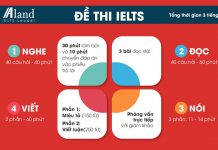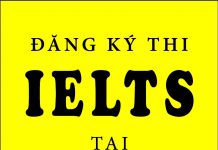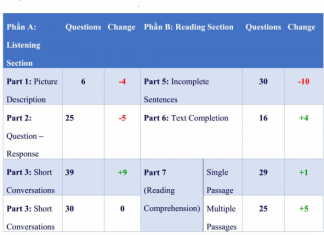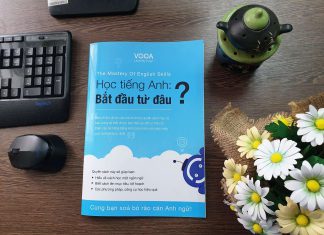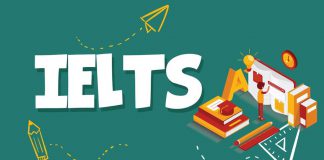Dao Thi Thanh Hao International Education Center, Hanoi University
Abstract. The present paper attempts to emphasise the mutual connection between testing and teaching in light of evaluating the effectiveness of task-oriented IELTS activities on the performances of IELTS trainees in their reading test. For this purpose, the learners in an IELTS preparation center in Hanoi were treated with IELTS reading materials under the adoption of task-based language teaching approach (TBLT) for three months. Two instruments to collect data were employed, namely Pre-IELTS Test and Post-IELTS Test, and a questionnaire. The study reveals that after the experimental time, the participants’ reading scores improved considerably.
Keywords: Task-based Language Teaching (TBLT), Reading skill, IELTS.
1. Introduction
IELTS, abbreviated from International English Language Testing System is a task-based testing system, has become recognized as an international benchmark for proficiency in English. This system measures the four language skills of listening, speaking, reading and writing, which candidates need to study or practice in the medium of English [6;2]. Among these four skills, reading skill appears to be challenging for a massive number of test takers. Especially, tackling with the questions in an IELTS reading test requires candidates with a variety of interrelated skills, rather than one skill only or even mainly one skill” [1;436].
This is because IELTS reading tests assess a candidate’s general reading comprehension, knowledge of vocabulary and use of reading strategies [22;60]. Therefore, it is important to have a suitable approaches to help more and more candidates succeed in IELTS reading test. Among them, task-based language teaching (TBLT) has been regarded as a suitable and effective approach to promote students’ reading skill in doing IELTS reading test.
In the early 1980s, TBLT came into play with syllabus of its own nature and the main roles of communication, social negotiation, interaction of learners in task management situations and the focus on meaning and functions [4, 8, 9, 10, 11, 15].

The effectiveness of task-based-language teaching in improving IELTS reading skill
The approach has been defined in a number of ways by various linguistics, educators, and researchers. Long owned a non-pedagogical definition of this terms as “a task is a piece of work undertaken for oneself or for others freely or for some rewards. In other words, task is meant anything people do in everyday life at work, at play, and in between“[12;89].
By contrast, Richards, Platt, and Weber defined TBLT in a more linguistic and pedagogical way when assuming a task as “an activity or action which is a result of understanding and processing the target language” [19;289]. This seems to be in line with what Prabhu defined, i.e. “an activity which required learners to arrive at an outcome from given information through some process of thought, and which allowed teachers to control and regulate that process” [18;44].
Nunan even made it clear when stating that by implementing a task, learners “get involved in comprehension, manipulating, producing, or interacting in the target language with the main focus on meaning rather on form” [16;10]. In this study, the definition of Nunan, and Richards, Platt, and Weber are underpinned the meaning of “task” in the reading lessons.
Specifically, the reading “task” in the current paper is defined as a reading classroom activities that involve learners in interacting with each other, comprehending the reading materials, producing their language output based on their comprehension of the materials under the support of the teacher.
The significance of TBLT in teaching reading skill has been researched and well-documented by a numerous researchers and teacher-practitioners. Regarding the first, during performing the task, students analyze the new words in different contexts and in different ways so it will reinforce their learning of vocabulary and language uses [14, 15, 21, 23, 24].
This is obviously useful for IELTS learners since each reading passage in IELTS reading test is set in various contexts, and usually extracted from authentic sources like magazine, books, newspapers, or journals. As regards to the second benefit, TBLT engages learners into cognitive process so they can properly comprehend the texts which are extracted from authentic materials [15, 19, 20].
Richards, Platt, and Weber explicitly referred cognitive process to “processing and understanding language” underlying several definitions [19; 289]. These studies were conducted in different contexts and have provided invaluable insights into the practice of TBLT in reading teaching.
However, the importance of this approach in improving IELTS reading skill has not been much exploited by many scholars. Therefore, this paper is an attempt to investigate the positive effects of IELTS-oriented tasks on the performance of candidates in their reading test. Two main research questions guided the analysis as follows:
2. Content
2.1. Methodology
2.1.1. Participants
The subjects of this study were 45 students consisting of 28 females and 17 males studying in an IELTS preparation course at an English center in Hanoi. They were at different ages ranging from 16 to 27 but their English proficiency was at pre-intermediate level or above with the aim that they can deal with the difficulty level of the IELTS exam content. Some learners’ data before and after the treatment were set aside and disregarded in order to avoid the intervening variables associated with this project.
2.1.2. Data collection and procedures
Data were collected through questionnaires, Pre-IELTS test and Post-IELTS test to obtain the finding about the attitude of the participants towards the use of TBLT in improving their IELTS reading skill and the positive changes (if possible) between the time before and after the treatment with TBLT.
First, the pre-test of IELTS reading was delivered to the participants for diagnosis purpose and homogeneity purpose of ascertaining the sample’s reading knowledge. After that, the learners were taught with IELTS reading materials under the adoption of TBLT for three months before they took the post-IELTS reading test. All of these tests were chosen from the book called Cambridge IELTS 10 [2] which all of the participants had never done before the time the current research was conducted.
The questionnaires were administered at the conclusion of the study to collect the information about the attitudes of the learners after the treatment with TBLT in their IELTS reading lessons. The questionnaires were adapted from Nunan for evaluating communicative tasks, including 20 questions divided into three sections [16].
The first section contained demographic questions to collect information about learners’ age, sex, and reading ability level. The second part was a 10 Likert-type item set, asking participants about their view on the uses of TBLT during lessons. They had to answer the questions by using a 5-point scale ranging from “strongly disagree” to “strongly agree”. The last section was 3 multiple choice questions about learners’ performance in reading test and also another 7 Likert-type questions about the influences of TBLT on their IELTS reading test results.
2.1.3. Data analysis & results
A pre-test and post-test of IELTS reading were organized at the commencement and conclusion of the study to compare the students’ results and to calculate the possible effects of TBLT treatment on their IELTS reading performance. The results are shown in two tables, as follows







